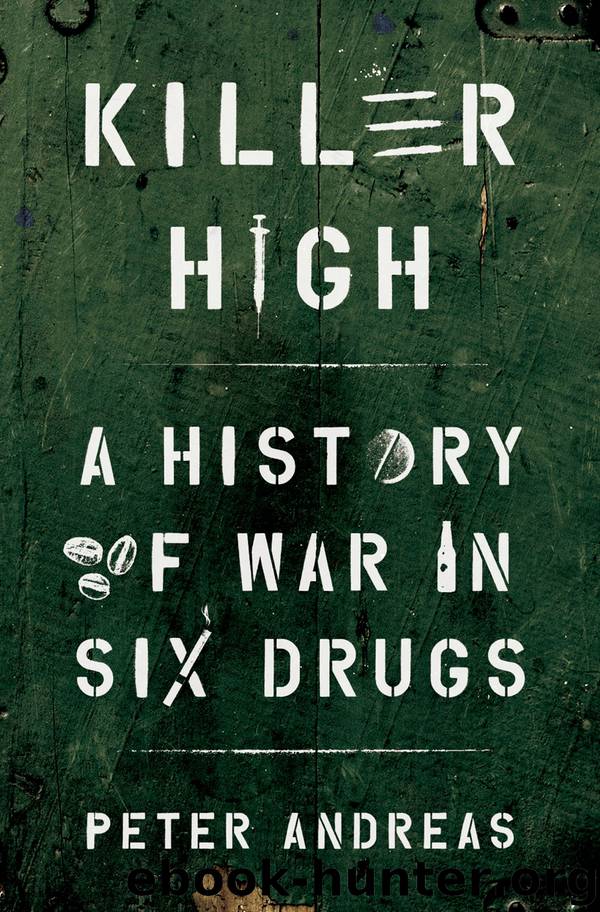Killer High by Peter Andreas

Author:Peter Andreas
Language: eng
Format: epub
Publisher: Oxford University Press
Published: 2019-01-15T00:00:00+00:00
Figure 4.6 A US Army colonel walks through an opium poppy field in Helmand Province in southern Afghanistan, April 2006 (John Moore/Getty Images).
To make matters worse, the United States also found itself backing an extraordinarily corrupt government in Kabul, one that also had deep ties to drug trafficking. As had been the case during the Cold War, a pragmatic calculus meant Washington was willing to overlook such ties and perhaps even take advantage of them. For instance, Ahmed Wali Karzai, the brother of the new Afghan president, was widely suspected of ties to the heroin trade before he was assassinated, but he was also allegedly on the CIA payroll.178 The United States also turned a blind eye to the appointment of Asadullah Khalid as the Afghani director of the National Directorate of Security. Khalid was a former governor of Kandahar and was widely accused of “abuses of power,” including murder, torture, and drug trafficking. The United States and its allies did not act on these allegations because, as Vanda Felbab-Brown puts it, “whatever his accountability deficiencies, Khalid had a proven record of being tough on the Taliban.”179
At the same time, the United States faced blowback from its earlier backing of drug-dealing allies. This was embarrassingly evident in the case of the Haqqani network in Afghanistan and Pakistan, whose criminal activities included drug smuggling. This network had enjoyed covert CIA support while fighting Soviet forces in the 1980s, but in 2011 it was responsible for orchestrating a bold daylong attack on the American embassy in Kabul and was described as the most dangerous security threat to US forces in Afghanistan. As one press report put it, in the 1980s the network had been supplied with US missiles; now it was the target of CIA missiles. Texas representative Charlie Wilson, whose support for the mujahideen was the subject of the Hollywood film Charlie Wilson’s War, had even described the elder Haqqani leader, Jalaluddin Haqqani, as “goodness personified.”180
Fifteen years after the US invasion of Afghanistan—with Washington having spent more than $1 trillion and counting on military operations—the war had no end in sight. The Taliban’s control over the drug trade continued to grow, expanding to cover much of Helmand Province, the heart of poppy cultivation in southern Afghanistan. But even in those Helmand districts where the government remained in charge, opium not only grew openly near military and police stations but was taxed by the local authorities. Despite the United States spending billions of dollars on antidrug efforts and billions more to curb corruption, local government officials had become so complicit in the drug trade that they were now apparently competing with the Taliban to profit from it. While the central government in Kabul repeatedly declared its commitment to fighting drugs and corruption, the reality on the ground in Helmand, as reported in the New York Times, was “a local narco-state administered directly by government authorities.”181
Even though most of the drug profits may have stayed in the hands of local officials, payoffs reached up to the regional and national levels.
Download
This site does not store any files on its server. We only index and link to content provided by other sites. Please contact the content providers to delete copyright contents if any and email us, we'll remove relevant links or contents immediately.
The Secret History by Donna Tartt(18849)
The Social Justice Warrior Handbook by Lisa De Pasquale(12142)
Thirteen Reasons Why by Jay Asher(8796)
This Is How You Lose Her by Junot Diaz(6794)
Weapons of Math Destruction by Cathy O'Neil(6146)
Zero to One by Peter Thiel(5686)
Beartown by Fredrik Backman(5599)
The Myth of the Strong Leader by Archie Brown(5425)
The Fire Next Time by James Baldwin(5249)
How Democracies Die by Steven Levitsky & Daniel Ziblatt(5128)
Promise Me, Dad by Joe Biden(5087)
Stone's Rules by Roger Stone(5026)
A Higher Loyalty: Truth, Lies, and Leadership by James Comey(4845)
100 Deadly Skills by Clint Emerson(4840)
Rise and Kill First by Ronen Bergman(4704)
Secrecy World by Jake Bernstein(4646)
The David Icke Guide to the Global Conspiracy (and how to end it) by David Icke(4625)
The Farm by Tom Rob Smith(4438)
The Doomsday Machine by Daniel Ellsberg(4416)
